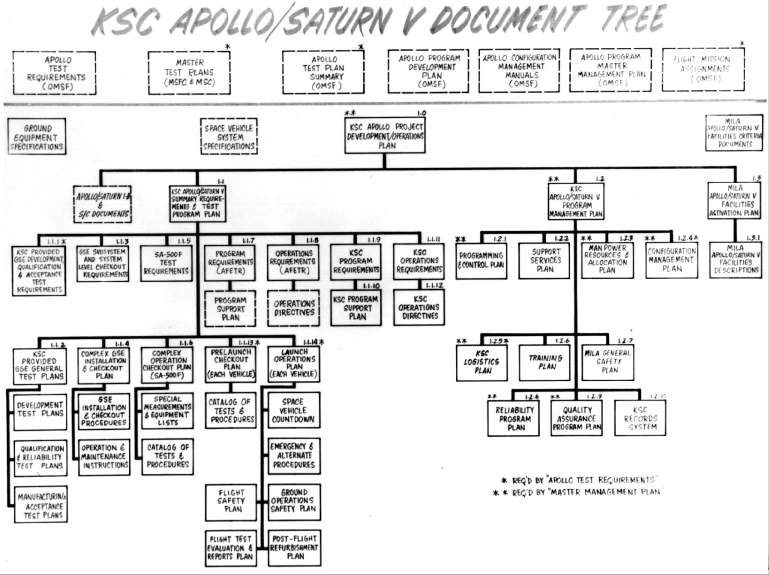
Data Management
On 29 October 1964, the year of the reorganization, in his weekly report to Debus, Petrone stated that his office was preparing a KSC regulation for implementation of the instructions received from Headquarters entitled "Apollo Documentation Instruction NPC [NASA Publication Control] 500-6." This instruction required the following action from each center: identification, review, and approval of all documents required for management of the Apollo program; "an Apollo document index," cataloguing all recurring interorganization documentation used by the Office of Manned Space Flight and the contractors; a "Center Apollo documentation index"; a "documents requirement list," listing all documents required from a contractor - this list would "be negotiated into all major contracts of a half million dollars or over" and would be part of the request for quotation; and a "document requirement description," classifying every item on the "document requirements list," its contents and instructions for preparation.48
This instruction, Petrone believed, could provide a strong management tool and eliminate many unnecessary documents. The procedure would classify and catalogue documents and make them readily available to anyone who had immediate need for them. It would force many contractors, especially those who had not previously dealt extensively in government contracts, to clarify in writing the exact nature of their roles in the Apollo program. Throughout the entire program, specific delineation of each phase would bring greater clarity to the respective tasks.

A document tree for Apollo-Saturn V, December 1964.
At various times Kennedy Space Center put out Apollo document trees - charts showing the relationship of key documents. On 3 November 1965, for instance, Petrone was to authorize the "KSC Apollo Project Development Plan" under three categories of documents: Apollo Saturn IB Development Operations Plan, Apollo Saturn Program Management and Support Plan, and Apollo Saturn V Development Operations Plan. Within the second category were ten areas of concern to management: program control, configuration management, reliability and quality assurance, vehicle technical support, administrative support, logistics, data management instruction, training, general safety, and instrumentation support. The other two categories had 31 and 44 topics respectively! Typical of those that appeared in both the Saturn I and Saturn V listings were the space-vehicle countdown procedures, the prelaunch checkout plan, and the launch operations plan.49
With even its paper work organized, the Debus team had come a long way from the Launch Operations Directorate of 1960 to the John F. Kennedy Space Center of February 1964. Many problems with the Air Force had been resolved, without undue antagonism resulting. Land on Merritt Island had been purchased for the manned lunar landing program, plans laid for launch facilities and an industrial area, and construction had begun. The center had recruited a roster of engineering and administrative personnel and devised a workable organization.
The new organization did not mean an improvement in every respect. It involved the development of a bureaucracy that was incompatible with the informal, personalized approach of the old days on the Cape. Then the engineers had inspected their instruments, worked on them, sometimes built them; they labored with their hands. Now, they monitored contractors.50 Meetings with department heads and even the Director had been highly informal. Now secretaries scheduled the meetings, each of which required a detailed agenda, and division heads presided with the formality of a college dean at a faculty meeting. Because the men who launched rockets were a sentimental crew, there were frequent references to the good old times. But to launch a rocket that would put a man on the moon, they recognized, required an extensive organization.
| Next |